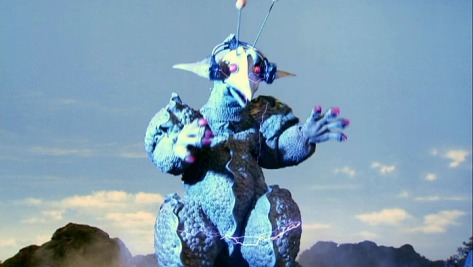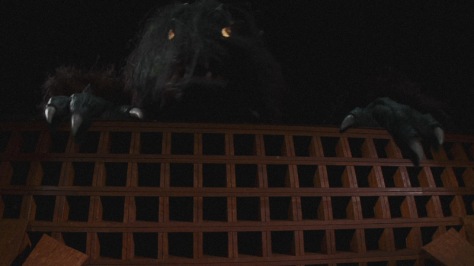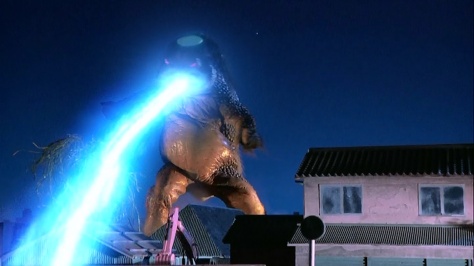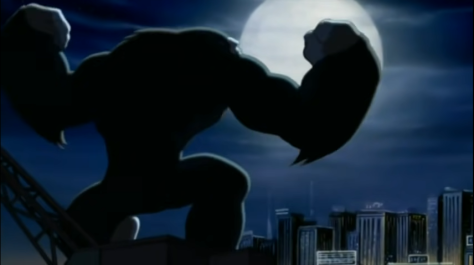

Let’s return to the Showa era, and examine how the Godzilla series looked towards the youth in two different ways.
Continue reading Zillatinum: Part 3 (All Monsters Attack & Godzilla vs. Gigan)

Let’s return to the Showa era, and examine how the Godzilla series looked towards the youth in two different ways.
Continue reading Zillatinum: Part 3 (All Monsters Attack & Godzilla vs. Gigan)
Previously—as in almost five years ago—I wrote about the sixties tokusatsu adaptation of “God of Manga” Osamu Tezuka’s series Ambassador Magma, notable not only for its connection to a major cultural figure in Japan, but for being one of the early superhero-vs-kaiju television shows (premiering a week before Ultraman in 1966), and one that was also localized into English as The Space Giants. This is all to say that the Ambassador Magma namedoes hold some historical significance, which would explain why it received a second adaptation in 1993, four years after Tezuka’s death (conveniently, the dubbed versions of all thirteen episodes are available to view on the official Tezuka Youtube channel.) Released as a thirteen-episode OVA series by Bandai Visual and the Tezuka-founded Mushi Productions (among many credited animation studios) during the boom period for direct to video animation in Japan, the newer version of Magma adapts to its era and format much in the same way the previous adaptation did—I’m sure anyone who has sampled the kind of violent, genre-heavy serials aimed mostly at fans with disposable income will recognize the animation style and rhythms of this series as well. What’s interesting to me is seeing how Tezuka’s humanistic tendencies blend with that aesthetic—which in this case translates to a mix of the grotesque and the sentimental.
Continue reading Ambassador Magma (OVA Version)
Yes, this is indeed a much belated follow-up to The X From Outer Space, the second tier kaiju film from Japan’s sixties Monster Boom period that I covered over four years ago, and from the subtitle alone you are probably left with many questions. A nominal parody of both the original film and the state of geopolitics circa the late aughts, this one-off reboot is brought to us by director Minoru Kawasaki, who specializes in comedy tokusatsu projects with names like The Calamari Wrestler and Executive Koala, and writer Masakazu Migita, an Ultraman TV series writer who has worked with Kawasaki on multiple projects. Migita was also the writer of previous subject Death Kappa, and while this certainly shares comedy stylings with that movie, it benefits from having a direction to its humour beyond just slightly off-kilter recreations of older kaiju films.
Continue reading Monster X Strikes Back: Attack the G8 Summit (2008)
As we’ve frequently seen (even as recently as last week), the spirit of fifties B-Movies remained—and arguable remains—strong in creature features, and one part of that legacy is embracing the poor reputation the low-budget monster movies in the black-and-white era often had. Making fun of that particular oeuvre—their overly-expository and unnatural dialogue, their toy-like special effects, their nonsensical plots—has been a go-to for decades, and I can imagine that seeing so many of those movies turned into comedy fodder on something like Mystery Science Theatre 3000 broadened their audience and extended their period as laugh material for another few decades. A movie like The Lost Skeleton of Cadavra is an obvious outgrowth of all that: a conscious pastiche of lousy programmers, their most ridiculous traits amplified while still keeping as much of the look and sound of the real deal as possible. Even with the ubiquity of this particular brand of parody, I’m sure there was still a sense of novelty to seeing a movie like this in the early aughts, especially when it was distributed by a major studio like Tristar (three years after it premiered at film festivals), who even let their logo be shown in black-and-white to match the spirit.
There was a time where I would have taken this sort of thing at face value, but after years of watching the kinds of older movies that inspired Cadavra, the experience of watching it feels a bit different. When these fifties B-movies were something a bit more distant—a strange and infrequent discovery on late night television, all blurring together in your memory—the kind of schlock being mined for comedy here probably felt accurate to the general atmosphere. But when you really drill down into the lesser-known genre flicks of this period, you find that they are often much more interesting than their reputation says, offering weirder sights and sounds and wilder ideas even with their budget-constrained nature. Shockingly, you also find that these movies were entirely capable of making fun of themselves in the moment, the filmmakers knowingly playing up their own ridiculousness at a time when irony was not expected. If the targets of mockery have already been cracking all the same jokes this whole time, then what, exactly, can a comedy pastiche made over four decades later bring to the table?


1964 was the turning point for the Godzilla films—after ten years and four movies, the series not only solidified into what it would be for the rest of the Showa era, but what it would be in all the years beyond that. After hitting on the kaiju battle premise in Godzilla Raids Again, King Kong vs. Godzilla, demonstrated that having multiple monster headliners duking it out brought in audiences like nothing else. As we have seen in the sixty years since then, it’s a pitch that finds its way back into public favour even after a period of downtime—watching two or more big monsters fighting hits a primal nerve.
These shifts in focus inevitably changed how the stories were written—for one, humanity was no longer living in a world where monsters were a freakish and tragic aberration, but one where they are woven into the fabric of existence. More importantly, though, was how all of this altered the depiction of Godzilla, which spoke of changing attitudes in Toho and possibly in the populace. Although the tone of the movies had significantly softened after the stark nuclear terror of Ishiro Honda’s original, one thing that stuck around even with the relative optimism of Raids Again or the lighthearted spectacle of KKvG was the idea of Godzilla as the ultimate threat, a walking disaster that humanity must contend with again and again as a constant reminder of what they had brought upon themselves. In 1954, Godzilla’s atomic origins made it feel like a new existential problem for life itself—but what happens when that becomes normalized? If Godzilla is eventually part of everyday life, how are we supposed to see him? Could he even become something more than a menace?
Circumstances at Toho led to the regular monster movie crew producing two movies in the Godzilla series in 1964 (with Dogora released between them), and you can see the drastic shift in the tone of this series happen in real time as you watch them. Godzilla gets one more round as the antagonist that brings humans (and more benevolent monsters) together—but within a few months, the tables turn completely, and it is Godzilla himself that humanity turns to for help from an even greater threat. There is something of a logical through line in this—Godzilla’s subsequent change into monster hero did not come from nothing—but it still rather dramatically realigned how these movies would be made from then on.
Continue reading Mothra vs. Godzilla & Ghidorah, the Three-Headed Monster (1964)


Japan is another country where giant monster movies are produced. Did any of you know this?
In the gaps between major kaiju films, you can always expect to see alternative sources pick up the slack, including fans. The late aughts and the early 2010s were one of those gaps, and while neither of the two subjects I’m covering here, one a short film that aired on television and the other a feature-length film that comes off as multiple short films cobbled together, are technically fan-produced, they certainly feel like they are. They carry with them the same loving attempts to recreate classic tokusatsu effects (utilizing veterans of the field), and the same desire to fill as much of the cast with recognizable faces from other tokusatsu productions—all things we saw in previous site subject The Great Buddha Arrival, which is an actual fan-made film. In this case, both are also affectionate parodies of the genre, capturing the technical craft while making light of their cliches—with that in mind, another one of their major similarities to each other might be their oddly uneven approach to spoofing the form.
Continue reading Geharha: The Dark and Long-Haired Monster (2009) & Death Kappa (2010)

The popularity of the Godzilla films in their heyday did not just lead to homegrown competitors and imitators—as we saw with Yongary and Gorgo, film makers worldwide sometimes made their own attempts at similar monster material. I’ve written about that particular “Monster Boom” period pretty extensively, but a very similar pattern emerged following Pokémon, a later monster-based phenomenon that was clearly inspired by nostalgia for the original Monster Boom. That series’ thundercrack emergence in the late nineties led to a plethora of other media based on the idea of monster collecting and battling, especially in Japan, and I’ve written about some of those as well (you can also find a surprisingly deep recollection of even more Pokémon coattail riders in Daniel Dockery’s 2022 book Monster Kids)–but wouldn’t it be interesting to see how the basic ideas of a monster collecting franchise could be filtered through a completely different cultural lens?
This brings us to Monster Allergy, an Italian kids comics-turned-attempted-franchise that doesn’t outright announce its indebtedness to Pokémon and the other kids monster series of its era, but come on—it’s about “monster tamers” capturing monsters in small objects, and that alone makes the connection obvious. It’s certainly no rip-off, as any similarities largely disappear past those barest of surface elements, and instead follow more traditional western low fantasy storytelling. But regardless of the degree of intention, this does represent a very European take on some of Pokémon‘s core ideas, a kid-focused adventure in a monster-filled world, and In this way, it is to Pokémon what a Gorgo or a Reptilicus was to the original Godzilla.

How long has it been since I wrote about a yōkai movie? Clearly, far too long.
I’ve already written quite a bit about the long history of tokusatsu depictions of Japanese spirits and monsters, which bridge the traditional stories and the modern kaiju and kaijin material that take inspiration from them. Considering that deeply-rooted connection, you can understand why some tokusatsu production lifers would eventually choose to make something yōkai-related—and Sakuya: Slayer of Demons (Japanese subtitle Yōkaiden) is a prime example of just that. Director Tomoo Haraguchi’s “tokusatsu lifer” status is inarguable: he started out working on models and make-up as far back as Ultraman 80 in the early eighties, eventually working on to previous site subject Ultra Q The Movie and the the nineties Gamera trilogy (more recently, he has some credited design work on Shin Ultraman.) The movie he produced is a smaller scale project that showcases some of what classical effects could do in the new millennium, one set of traditions nestled within a story based on a much older set of traditions.

Released a mere nine months after the original King Kong in 1933 (this will post just two days shy of its eightieth anniversary), Son of Kong’s rapid turnaround leaves it in a bizarre place, a sequel that feels supplementary to what is probably the most important monster movie ever made. It has never been a particularly beloved movie, and despite the involvement of all the key people behind the scenes of the original—producer Merian C. Cooper, director Ernest Schoedsack, screenwriter Ruth Rose, and stop motion artist Willis O’Brien and his crew—one can detect how the rapidity of its creation rendered it a half-formed footnote (only sixty-nine minutes in length) even when it was new. King Kong inspired multiple generations of monster fans and left an entire form of storytelling in its wake—Son of Kong, not so much.
That hasn’t stopped me from being fascinated by this movie, because for all the ways it will forever toil under the shadow of its predecessor, it is historically important in several low-key ways, representing a major shift in the evolution of both King Kong and of monster movies as an idea: it is the point where the underlying sympathy for the monster comes to the surface. Now, this is a legacy that I’ve technically started writing about backwards, after I covered Mighty Joe Young last Christmas Apes season—that was the second movie by Cooper, Schoedsack, Rose, and O’Brien to take the sympathy they had built for Kong and rewrite it into a lighter story. As I argued there, this could come off as a commercial decision, but it also feels like a product of some phantom sense of guilt, and a desire to show that no matter how King Kong turned out, it is possible for humans and amazing creatures like Kong to co-exist peacefully, if they just got to know each other. What they would do with Mighty Joe Young begins in Son of Kong, but what’s particularly intriguing is, in the latter’s close proximity to the original Kong, it shows just how soon the original crew began to reconsider how a monster movie could operate.

In another time, on another website, I wrote parallel analyses of a Godzilla cartoon and a King Kong cartoon, two series with no real relationship to each other that nonetheless called for comparison due to the title monsters’ interlocking history. Decades later, television was briefly rocked by the arrival of another Godzilla cartoon and another King Kong cartoon (and not the other other King Kong cartoon that I already wrote about), but this time their proximity was far closer and their parallel existence seemed far more intentional. Wikipedia and the fan sites that steal from Wikipedia claim that Kong: The Animated Series, a product of the Bohbot/BKN cartoon factory alongside French animation studios Ellipsanime and M6, was created to “rival” the FOX-airing Godzilla: The Series, starting its two-season, forty-episode run just as the other series was ending, airing briefly on FOX and in syndication from 2000 to 2001. As one would expect from anything said about a piece of pop culture ephemera on the Internet, there is no source for that claim, and most of the surviving press releases and industry pieces from the time I browsed made no mention of Godzilla—but I can at least understand where the assumption came from. In the year 2000, with nothing going on in the series movie-wise, what other reason would someone have to make a King Kong cartoon but to pit it against the ape’s scaly counterpart?
Of course, the caveat there is that, despite all appearances, Kong: The Animated Series is probably not an official King Kong cartoon (I also think it stole its logo from the movie Congo, which definitely won’t be featured on this site soon very soon.) Rather than a revival, even if an odd one, this is actually a clever theft that likely fooled every child in its audience with its quasi-authenticity. But, as it turns out, that is only one of the many strange things I discovered by digging up this copyright-eliding incarnation of the world’s premier giant primate.